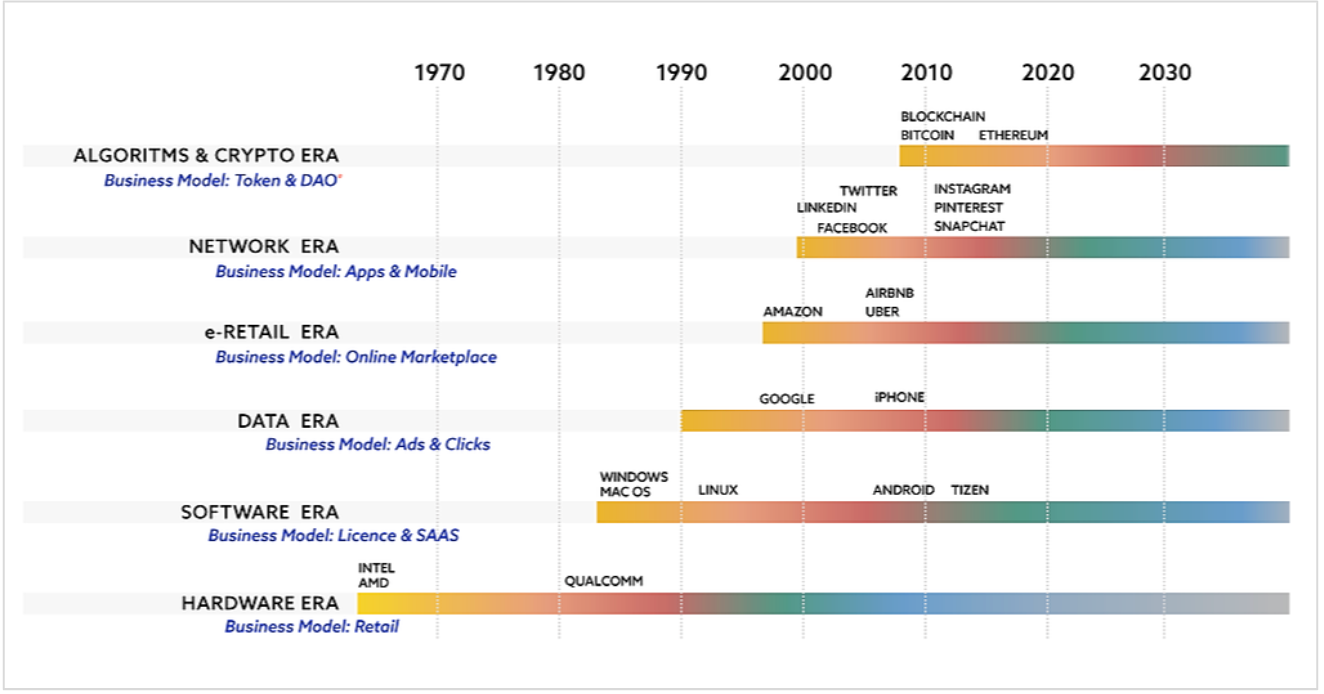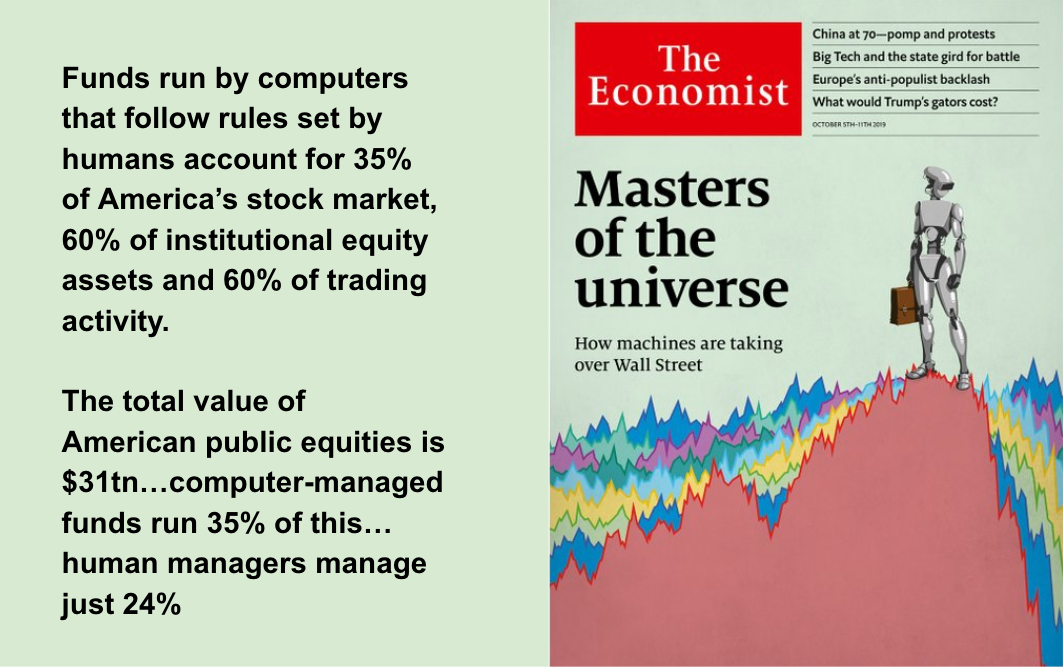AI is weakening various components of incumbent financial institutions, thereby creating an opportunity for an entirely new operating-models and category-dynamics focused on the scale and sophistication of product, tech & data much more than the scale or complexity of capital.
Unlike past ‘AI Springs’, the science and practice of AI is poised to continue an unprecedented multi-decade run of progress. A clear vision of the future financial landscape is critical for good governance and strategic decisions.
Key trends in AI-driven Fintech for next 10 years:
1) Death of manual underwriting and the dawn of ‘just-in-time’ lending paradigm. AI systems will eventually underwrite credit and insurance across the world. Future product experiences will be centered around AI, which automates most of the customers’ financial lives and improves their financial outcomes. AI capable of real-time analysis and decisions (e.g. credit adjudication) will trigger the “just-in-time” lending paradigm. Customers will get more for their money as insurance policies will become cheaper and coverage will be more complete. Analysts, lenders, underwriters, and money managers, — any job that involves crunching numbers to estimate a return — is at risk.
2) AI + Blockchain: Deus ex Machina- The ‘ultimate’ future. Both AI and blockchain involve technical complexity and the joint use of the two technologies might alter the tech and business paradigm significantly. Blockchain offers a source of immutable data that does not require centralized verification, which could be critical for identity management. AI will enable increasingly complex and automated smart contracts to be executed, allowing more blockchain use-cases to enter the mainstream. Some of the applications would be: AI Marketplaces, Crowdsourced Predictive Models for Hedge Funds, Collective AI Investment Management Platforms.

3) Reduced Financial Crime, NLP and Compliance Automation: Risk and Compliance functions suffer from massive data load and exhaustive regulatory requirements. Using NLP to understand fintech regulation by local governments can help create context-sensitive policy tests (an unambiguous set of can-do and cannot-do lists that any fintech would have to follow in the jurisdiction. Very similar to how security policies are applied to AWS IAM users). Network analytics helps determine connections between individuals to evaluate risky parties and networks, leading to a reduction in financial crime as increased transparency and liquidity makes for easier anomaly detection.
“AI will become a standard feature in applications, not a novelty”
4) Payments will lose “intermediaries”: As payment platforms become ubiquitous, interoperability will be the norm. With increased payment volumes, manual processes will be automated. Intelligent systems will perform the onboarding and know-your-customer procedures, run payment backends, continuously scan millions of transactions for patterns of fraud and future industry trends as well as sales and marketing opportunities. In the future, when customers will interact with payment systems, in the first instance they will almost always do so through AI.
5) True emergence of Fintech Cloud and Infrastructure (BaaS/IaaS): A true BaaS platform — managed service that lets developers and data scientists build and run superior machine learning models in production, and enabling them to build their own financial products, together with a fintech cloud (similar to ML cloud) would be the next step in infrastructure evolution. It lends superiority over traditional ML cloud because of scale and functionality.
“Technology goes beyond mere tool making; it is a process of creating ever more powerful technology using the tools from the previous round of innovation.” –Ray Kurzweil

6) Augmented financial wellness and security in an AI-driven paradigm. AI is creating new differentiators, driven by access to unique datasets and virtuous cycles of data. Targeted towards long term financial wellness and immediate-term financial security, — intelligent diagnosis and technology to help the user cultivate stronger savings, deposits, pensions, dividend-income and long-term investment habits will be an important play. Example — A recommender engine that converts maximum user input into a customized and optimized full-stack investment plan.
7) Platform shift and the ubiquity of Voice-First Fintechs: Voice is the future of Search, Commerce, and Payments. As voice becomes default UI, there is a huge opportunity for voice-first fintech companies solving for a variety of use cases. Example:
- On-demand micro-credit — “Alexa, can I borrow $300 from A?”
- Transactions — “NEO, send George $200 from my DBS account.”
- Investments — “Alexa, buy $100 of Bitcoin for me.”
We’re entering the age of intelligent applications, which are purpose-built and informed by contextual signals like location, hardware sensors, previous usage, and predictive computation. They respond to us when we need them to and represent a new way of interacting with our devices. Human-Voice will be the primary interface.
“Voice may be the foundation to the whole thing”
8) AI and the new battlefield for customer loyalty. AI will personalize payroll, benefits, salary-linked offerings. Everyone manages their paycheck differently and the ‘straitjacketed’ options by banks and employers do not solve everyone’s problem. With AI, however, a deeper analysis of transaction history leads to customization and contextualization. As past methods of differentiation erode, AI presents an opportunity for institutions to escape a “race to the bottom” in price competition by introducing new ways to distinguish themselves from customers.

9) Increasing complexity, governance, and power of data regulators. While AI is being used to assist regulations and compliances, there is a fear that it holds back fintech. Regulations governing the privacy and portability of data will shape the relative ability of financial and non-financial institutions to deploy AI, thus becoming as important as traditional regulations to the competitive positioning of firms. Regulators will need to cope with the increasing complexity of data management, and consider their role in protecting consumers while facilitating innovation.
More ML-related compute is going to happen on the edge
10) Spending-to-income-habits indicator will overtake credit score: How responsibly one spends the money will become a stronger indicator of creditworthiness than all bureau data score. Reason — bureau data changes after the fact when the user commits a mistake with their loan utilization and repayments. Spending-to-income indicator data can pre-empt potential default rates and therefore remove the need of having a credit score. This also democratizes credit as not everyone may have a credit score, but everyone has a spending habit.
11) Death of deposits, and growth of newer asset classes, and investment vehicles: Independent Robo-advisers can disintermediate asset managers from the investment process, reducing the cost of managing portfolios for clients. At the composition level, an AI will perform significantly better sans human biases. There will be newer classes of investments that will have divergent goals like environment, philanthropy, etc with so-called “impact investments”. The demarcation between spending, borrowing and wealth management will break down as one service-based offering manages the flow of customers’ money across multiple accounts, leading to the creation of new connections between capital and assets.

Funds run by computers that follow rules set by humans account for 35% of America’s stock market, 60% of institutional equity assets and 60% of trading activity. The total value of American public equities is $31tn… computer-managed funds run 35% of this… human managers manage just 24%.
The evolution:
— Gaurav Sharma (@Gaurav1105) November 28, 2019
BANKS TODAY = CASH, CAPITAL, LOANS TRANSACTIONS
BANKS TOMORROW = SOFTWARE, DATABANK, PLATFORM, MARKETPLACE
BANKS DAYAFTER = ASSET NETWORK & LIFE SCRIPT#BankofFuture 🏦
12) Collaborative AI and collective solutions for shared problems: Collaborative solutions built on shared datasets will radically increase the accuracy, timeliness, and performance of non-competitive functions, creating mutual efficiencies in operations and improving the safety of the financial system. This is a way to escape the “race to the bottom” market paradigm.
“The last 10 years have been about building a world that is mobile-first. In the next 10 years, we will shift to a world that is AI-first.” -Sundar Pichai
It is important to understand that AI does not exist in a vacuum — its capabilities will be intertwined with the development of all other technological innovations. Emerging technologies are mutually reinforcing, and the advances in any one technology will increase the capabilities of all other technologies that interact with it.
Change is coming and it’s coming fast and it will only accelerate.
